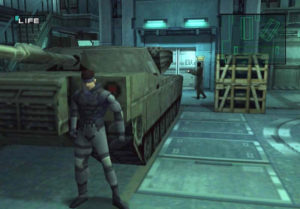WEST LONG BRANCH, N.J.–As video games have progressed, they have gone from simplistic, pixelated screens to full-fledged experiences, often with as much effort put into story, music, and visuals as a major feature film. Games often have voice actors, well-thought-out plots, and composed soundtracks to set the mood.
But in games themselves, there is something that allows the player to feel like they are part of a cinematic story while they are playing. A cutscene or character voice is one thing, but what games use their actual gameplay to pull players into its story in the same way a blockbuster does?

“Personally, I’d recommend the original ‘Metal Gear Solid,'” said sophomore gamer Julian Garcia. “To me, the amazing aspect of it is making sure the enemies and obstacles of the game don’t know you exist, and this makes it purely exhilarating.”
Using a specific style of gameplay to create tension between the story’s exposition really does help the player be immersed into the game’s world, as well as be interested in what will happen next. Too many games today simply list an objective in the top right of the screen for the player to accomplish, which throws immersion right out of the window.
“Gather 10 objects, eliminate this target”–this simply does not make for an exhilarating game, or even breaks the tension of an already exhilarating one. To truly be immersed, look no further than a game’s atmosphere, which is something games like “Metal Gear Solid” do superbly.
“Maybe its [the game] feeling like a film is what makes me love it,” added Garcia.

Even more than the setting a game places you in, the characters and tasks the game gives to a player is what makes it feel like more than just a game.
“I think the part of the games that help tell the stories are the missions and the other characters involved in your missions” said junior Jessica Schue. “Because otherwise you’re just running around pointlessly during a whole game which can be really boring.”
A game should have interesting things for a player to do and experience, and to make the game’s world feel more fleshed out. “Dragon Age,” a personal favorite, places an emphasis on interacting with companions when not fighting enemies. This allows the player to feel like there are genuine people along for the ride, rather than faceless mannequins that they have control over. When the world that a game places you in has the same kind of lovable characters you might find in a film, it makes the experience that much more special.

Now, regardless of what atmosphere or well-written characters a game has, there remains the most important aspect: the technology that goes into a game.
“I believe video games have been cinematic for a long time now, since at least the era of the [PlayStation 1] and [Nintendo 64],” said freshman Dan Vickey. “Since then, developers have only been improving that. Making them more visually appealing, adding player interactivity, and soon with the introduction of [virtual reality] will allow the player to literally place themselves in the action.”
While virtual reality gadgets like Oculus Rift, a VR headset that allows players to step into a game in first-person, are not yet mainstream, they are gradually making their way there. Games have always been moving forward in innovation, so it is encouraging to think how much farther they can go to bring players into them.
So, are games really cinematic? It depends on the game, but the true experience is being pulled into the story or world that a game presents to the player, making it an exceptionally special and unique medium of entertainment.




